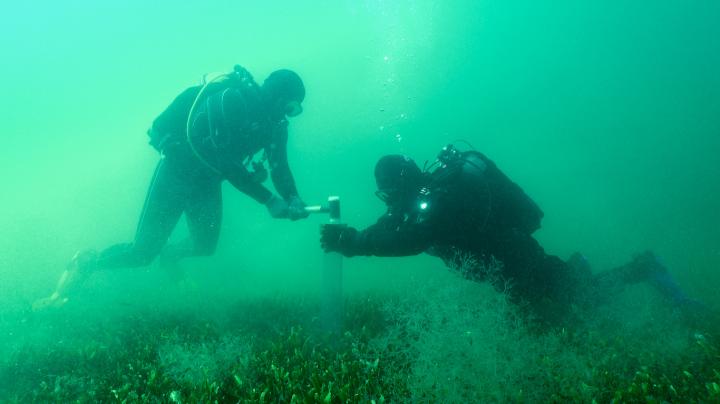Researchers from the ICTA-UAB and the UPCT will analyze the entry routes of nutrients, trace metals and pollutants caused by human activity into the Mar Menor

Credit: Balky Sub
A scientific project led by the Institute of Environmental Science and Technology of the Universitat Autònoma de Barcelona (ICTA-UAB) and the Universidad Politécnica de Cartagena (UPCT) will study the major pathways delivering nutrients, trace metals and pollutants originated from human activity into coastal lagoons of the Mediterranean. It will use the analysis of the Mar Menor (Spain) as a model, the largest coastal lagoon in the Iberian Peninsula and one of the most ecologically degraded.
Coastal lagoons are habitats with high biological productivity, supporting rich ecosystems and providing goods and services for coastal communities. The Mediterranean basin hosts around 400 coastal lagoons, covering an area of more than 641,000 ha. Some of them have been used since ancient times for fishing activities and are part of the cultural heritage of the regions. However, the increased human stress on lagoonal resources has negatively impacted these ecosystems. The intensive exploitation of the soil and biological and hydrological resources has led to aquatic and marine pollution and loss of habitats, among other severe impacts, researchers warn.
The project “Origin and Pathways of Anthropogenic solutes into coastal Lagoons: groundwater, sediments and episodic events” (OPAL) aims to analyze an abundant number of substances present in the water (nitrate, lead, mercury, stable isotopes, pesticides, etc.), their origin and the major pathways into the Mar Menor. “Human pressure on coastal lagoons increases the presence of nutrients and pollutants, which are mainly originated from untreated domestic or industrial sewage and the use of fertilizers for agriculture in the surrounding watersheds”, explains Marisol Manzano, from External Geodynamics Area of the UPCT. She recalls that this may result in eutrophication processes, characterized by low availability of oxygen and light in the water, phytoplankton blooms, reduced seagrass beds, and consequently, high fish mortality. However, she highlights that the mechanisms that transport these substances to the waters of the lagoon “are not known in sufficient detail”.
Jordi Garcia-Orellana, researcher at the ICTA-UAB and at the Department of Physics of the UAB, indicates that while the role of surface water discharge (rivers, watercourses or surface runoff) as a source of solutes to coastal ecosystems has been well documented, other pathways delivering nutrients and pollutants have been largely overlooked to date. “The discharges of groundwater, or the recirculation of the lagoon waters through sediments enriched with nutrients and other substances dissolved in the water are important sources of pollutants that have not been taken into account on a regular basis”, he says. Researchers highlight the role of this type of process, particularly in arid and semi-arid areas characterized by the limited presence or even absence of rivers and permanent streams.
For his part, ICTA-UAB researcher Valentí Rodellas recalls that the Mar Menor is an ideal study area, since it is a place where many studies have been conducted on hydrogeology, hydrodynamics, biology, ecology and socio-economics. “This lagoon is also an ideal model for this proposal because the system is subject to significant anthropic pressures that have resulted in a degradation of its ecological status, including tourism, agriculture (intensive irrigated crops in the watershed, the Campo de Cartagena) and a historic mining exploitation (Sierra de Cartagena-La Unión)”, he concludes.
The project is funded by the Ministry of Science and Innovation through its call for the National Plan for Science «R&D Projects» in the «Research Challenges» modality.
###
Media Contact
Isabel Lopera
[email protected]




